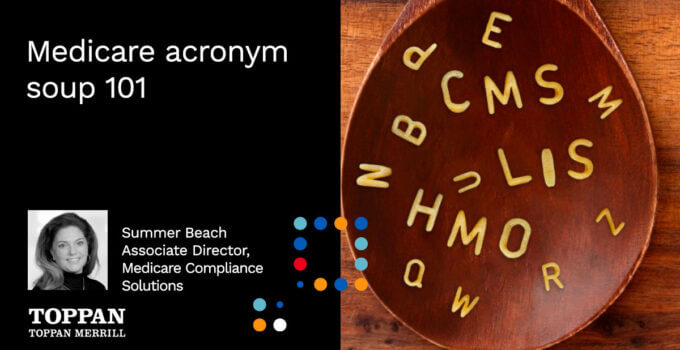9 min read | Industry Health Insurance Marketing & Communications
Acronyms are supposed to help us say more with less, right? If you remember trying in vain to form a word with the alphabet soup letters floating on your spoon, you might agree acronyms can become just as impossible to decipher. Health plans can easily over-use acronyms in their communications, causing confusion for their enrollees. For this reason, acronyms need to be strategically applied by the spoonful, not the ladle, to gently introduce important terms to the audience.
Let’s examine some of these “insider abbreviations” associated with Medicare Advantage plans, and how the use of acronyms can be applied by health plans to avoid confusion for a potentially vulnerable audience.
Common healthcare acronyms
TLAs – yes there is even an acronym for a three-letter acronym- are popping up everywhere in the Medicare Advantage kitchen. Below, we’ve dished up an appetizing list of core acronyms for you to sample, including those most frequently misunderstood by beneficiaries and even some industry professionals.
Medicare Advantage plan acronyms, and related terms
MA: Medicare Advantage (MA), is a Medicare-approved plan offered through a private insurance company. It includes Part A (hospital insurance), Part B (medical insurance), and sometimes incorporates Part D (prescription drug coverage). MA plans are also referred to as “Medicare Part C” plans as they essentially replace original Medicare by combining both Part A and Part B.
PDP: Prescription Drug Plan (PDP). PDPs are stand-alone drug plans offered through private insurance companies and provide coverage for prescription drugs from retail pharmacies. These are also referred to as “Part D” plans. Drugs covered under Part D are typically obtained on an outpatient basis, whereas drugs used during an inpatient stay are typically considered for payment as part of the hospital’s services.
MAPD: Medicare Advantage Prescription Drug plan (MAPD). A health insurance plan which includes prescription drug coverage.
HMO: Health Maintenance Organization (HMO) is a type of “gatekeeper plan” which requires an enrollee to obtain services from a designated clinic or set of clinics. Under an HMO plan, enrollees are required to have a Primary Care Physician (PCP) coordinating their care and referring the enrollee for most of their specialty services. Self-referred services are not typically covered through an HMO plan or are available only for limited types of care.
HMO-MA: Health Maintenance Organization – Medicare Advantage (HMO-MA). This type of MA plan does not offer drug coverage and is referred to as a “medical only” plan, operating under the same gatekeeper structure that requires a Primary Care Physician (PCP) for most services to be covered. The PCP must coordinate referrals to most specialists for payment of services.
HMO-MAPD: Health Maintenance Organization – Medicare Advantage Prescription Drug plan (HMO-MAPD). An HMO plan which offers both medical and prescription drug benefits.
LIS: Low Income Subsidy (LIS) is a program to help low-income Medicare beneficiaries pay for their prescription drugs. Also known as “Extra Help,” the program assists individuals with paying out-of-pocket costs like deductibles, copayments, or coinsurance.
PPO: Preferred Provider Organization (PPO). A plan which typically allows enrollees to see specialists in their plan’s network, and receive coverage, without obtaining a referral from a Primary Care Physician.
PPO-MA: Preferred Provider Organization – Medicare Advantage (PPO-MA) plan does not include prescription drug coverage for enrollees. This is referred to as a “medical only” plan, allowing self-referral to specialists within the plan’s provider network, without requiring referrals from a Primary Care Physician for services to be covered.
PPO-MAPD: Preferred Provider Organization – Medicare Advantage Prescription Drug (PPO-MAPD) plan offers both medical and prescription drug benefits.
OON: Out-of-network (OON) defines healthcare providers or pharmacies that do not have a contract with a health plan to coordinate or provide covered services to enrollees, or to provide services at a contracted rate. Contracted providers are defined as “in-network providers” and health plan enrollees usually pay less for services obtained inside the plan’s network.
LIS: Low Income Subsidy (LIS) is a program to help low-income Medicare beneficiaries pay for their prescription drugs. Also known as “Extra Help,” the program assists individuals with paying out-of-pocket costs like deductibles, copayments, or coinsurance.
PCP: Primary Care Physician (PCP) or Primary Care Provider. HMO plan enrollees must select a physician as their primary doctor, who then coordinates their care and referrals to specialists as needed. The physician they select is then referred to as their PCP.
CMS: Centers for Medicare & Medicaid Services (CMS) is the Federal agency responsible for administering Medicare and other government-sponsored health plans, including plans offered under the Affordable Care Act and Medicaid.
HHS: This is the U.S. Department of Health and Human Services (HHS), is a cabinet-level executive branch department of the U.S. federal government created to protect the health of the U.S. people and provide essential human services. HHS is the governing body of the Centers for Medicare & Medicaid Services (CMS).
LEP: Late Enrollment Penalty (LEP) is a monetary penalty added to a drug plan’s monthly premium when an individual delays their enrollment for Part D coverage to fall outside of their initial eligibility window. This penalty is calculated by Medicare and is added to the enrollee’s monthly premium for as long as they continue their coverage.
Common sources of confusion for enrollees
One of the most common complaints after an Annual Enrollment Period (AEP) occurs when beneficiaries discover they’ve enrolled in a plan they didn’t intend. The terms HMO and PPO can be easily confused in a hurried enrollment conversation. HMO, PPO, LIS, LEP, 123, you and me – the TLA’s can be overwhelming.
Whether enrollments occur due to someone “aging-into” Medicare, or during a high-intensity marketing campaign such as the Annual Enrollment Period (AEP), agents and customer service representatives should remain cognizant of the consumer’s challenge to differentiate plan types during plan selection.
Providing a friendly-paced, clear discussion with enrollees will support accurate enrollment and benefit payments. Enrollee complaints can be avoided, which will help boost your annual Star Ratings. Reduced complaints and improved customer satisfaction surveys contribute to higher Star Ratings and increased revenue for health plans.
Good soup – bad soup: will your acronyms float or sink?
Medicare enrollees have demonstrated acronyms to be a serious point of confusion causing issues with their plan selection. For example, members can purchase plans with medical coverage only, prescription drug coverage only, or an MAPD plan, which combines medical care and prescription drug coverage into one plan. What many enrollees may not understand, is that Medicare does not allow most MA plan types to be combined with other plans to expand coverage.
For example, an individual with an MA or “Medical-Only” plan, cannot add a PDP or “Drug-Only” plan to their coverage portfolio. Under current regulation the most recently enrolled plan will preside, and the previously existing plan will be canceled. Every year, there are beneficiaries who self-enroll and find themselves without medical coverage when they add a stand-alone drug plan, or vice-versa. It’s a complicated rule. However, individuals who want both types of coverage need to seek plans which already combine both coverages into one plan (MAPD). Very few exceptions apply. So, it’s important for beneficiaries to work through their enrollment options with a plan agent or representative, to avoid soupy mishaps due to acronym inundation.
Acronyms for enrollment periods
Acronyms that describe different enrollment periods may also confuse some Medicare enrollees and result in missed opportunities for timely enrollment without penalty, and/or, miss the yearly opportunity for changing plans.
The primary acronyms for enrollment periods include:
AEP: Annual Enrollment Period (AEP) is the annually designated timeframe for Medicare Advantage enrollees to change plans. The Annual Enrollment Period for members to learn about the next year’s benefits and change plans, falls between Oct. 15 and Dec. 7. An enrollee can continue to change their plan of choice throughout these dates, however, the last plan selected is the plan finalized to take effect for the coming year.
OEP: Open Enrollment Period (OEP) is the timeframe when health plan enrollees may change their AEP election. This is usually between Jan. 1 and March 31. OEP is only for those already enrolled in a Medicare Advantage Plan. During OEP, an enrollee can only change their plan one time.
SEP: Special Enrollment Period (SEP). SEPs allow enrollees to switch plans due to unforeseen circumstances or situations outside of their control. For example, SEPs may be granted to individuals residing in areas impacted by natural disasters, allowing extra time for enrollment. When the internet is down, the electricity is out and mail can’t be delivered, beneficiaries can’t even receive time-sensitive notifications much less communicate their preferences. CMS grants SEPs for natural disasters for those residing in impacted areas or those otherwise affected or displaced (determined by zip code and other verifiable data). More commonly, SEPs may be granted when a beneficiary relocates to a permanent residence outside of their current plan’s service area. An SEP for relocation can be requested so the individual can change to a plan servicing their new area, allowing benefits to be obtained by in-network providers.
SEPs must be requested and are approved only by Medicare. Other types of SEPs can be issued for a variety of unforeseen, mitigating circumstances.
Is your soup too thick? If so, add water…
Stew? Cream based? Broth? The clearer the soup is, and the simpler your communications are, the easier your acronyms can be to digest.
Health plans can improve readability of their marketing materials and required documents by simplifying the language used. Targeting your audience with reader-friendly terms, and explaining acronyms in a simple yet relatable way, may increase end-to-end reading of your documents and a better understanding of plan benefits.
Is overall language complexity a concern? Some plans use the Flesch-Kinkaid scoring method to determine reading level adequacy. If your documents are overly seasoned with acronyms, pass them through a reading-level test. You may find many of your TLA’s can be removed when using simpler terms. Apart from Flesch-Kinkaid, consider checking for any state-required reading level recommendations that may be based on grade-level reading scales.
In the plight to be concise, and avoid swimming in alphabet soup, remember the hazard of acronym over-use causes confusion and distracts from the main point of your communication. Pepper your communications as mildly as possible with clearly explained acronyms that are used in proper context.
How Toppan Merrill can help
Toppan Merrill offers several services, including document creation and management, sales enablement, omnichannel communications, printing services, and more. We deliver best-in-class solutions that help you respond quickly to changes in regulations, client needs, and markets.
Learn more about how we can help you with your mission-critical content by visiting our website.



